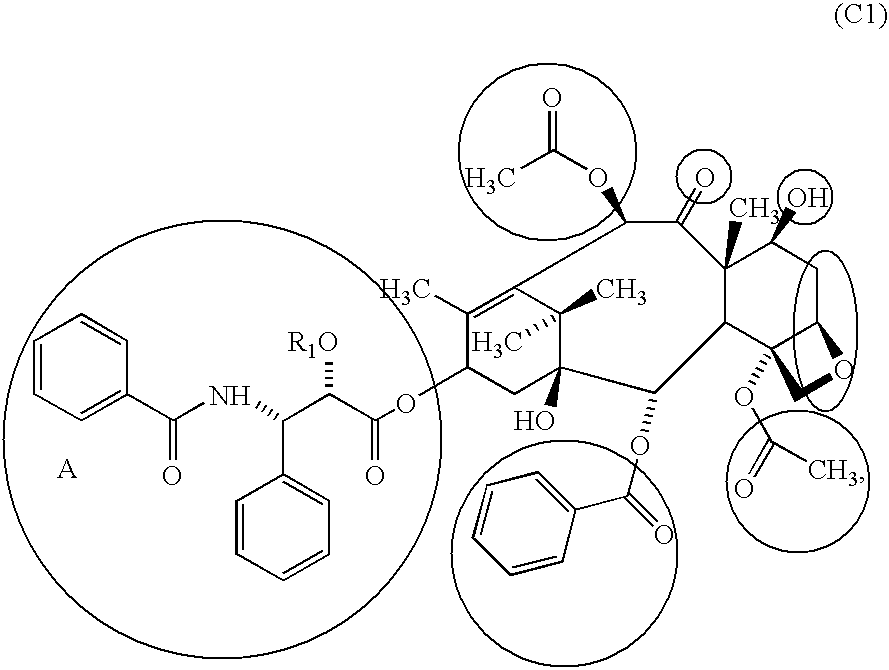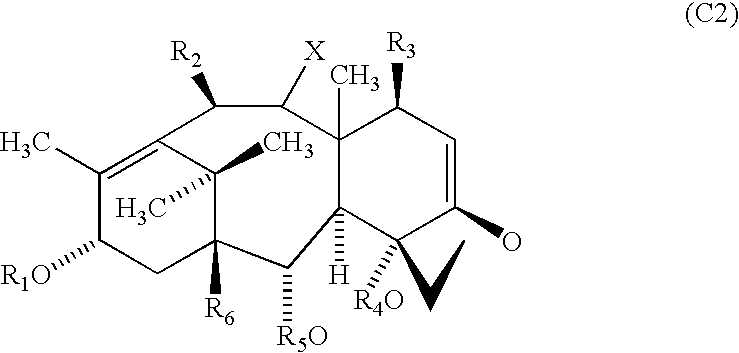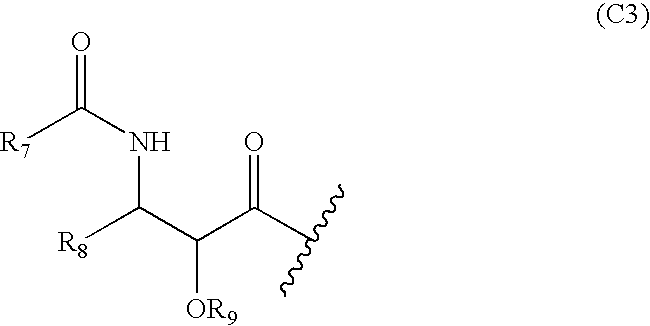Compositions and methods for treating inflammatory conditions utilizing protein or polysaccharide containing Anti-microtubule agents
- Summary
- Abstract
- Description
- Claims
- Application Information
AI Technical Summary
Benefits of technology
Problems solved by technology
Method used
Image
Examples
example 1
Production of a Micellar Carrier for Paclitaxel Dispersal
[0152] A micellar carrier for paclitaxel was prepared as follows. A 60:40 methoxy polyethylene glycol (MePEG):poly(DL-lactide) diblock copolymer was prepared by combining 60 g of DL-lactide and 40 g of MePEG (MW=2,000 g / mol) in a round bottom glass flask containing a Teflon™-coated stir bar. The mixture was heated to 140° C. with stirring in a temperature controlled mineral oil bath until the components melted to form a homogeneous liquid. Then 0.1 g (or 0.5 g in some batches) of stannous 2-ethyl hexanoate was added to the molten mixture and the reaction was continued for 6 hours at 140° C. with continuous stirring. The reaction was terminated by cooling the product to ambient temperature. The product, 60:40 MePEG:poly(DL-lactide) diblock copolymer, was stored in sealed containers at 2-8° C. until use.
example 2
Paclitaxel Dispersed in a Micellar Carrier to Make a 150 mg Vial Formulation
[0153] Paclitaxel was dispersed in the micellar carrier from Example 1 as follows. Reaction glassware washed and rinsed with Sterile Water for Irrigation USP, and dried at 37° C., followed by depyrogenation at 250° C. for at least 1 hour. First, a phosphate buffer (0.08 M, pH 7.6) was prepared. The buffer was dispensed at the volume of 10 ml per vial. The vials were heated for 2 hours at 90° C. to dry the buffer. The temperature was then raised to 160° C. and the vials dried for an additional 3 hours.
[0154] The polymer micelles (from Example 1) were dissolved in acetonitrile at 15% w / v concentration with stirring and heat. The polymer solution was then centrifuged at 3000 rpm for 30 minutes. The supernatant was poured off and set aside. Additional acetonitrile was added to the precipitate and centrifuged a second time at 3000 rpm for 30 minutes. The second supernatant was pooled with the first supernatant....
example 3
Paclitaxel Dispersed in a Micellar Carrier to Make an 11 mg Vial Formulation
[0156] Paclitaxel was dispersed into the micellar carrier from Example 1 as follows. Reaction glassware washed and rinsed with Sterile Water for Irrigation USP, dried at 37° C., followed by depyrogenation at 250° C. for at least 1 hour. First, a phosphate buffer, 0.08M, pH 7.6 is prepared. The buffer is dispensed at the volume of 1 mL per vial. The vials are heated for 2 hours at 90° C. to dry the buffer. The temperature is then raised to 160° C. and the vials are dried for an additional 3 hours.
[0157] The polymer was dissolved in acetonitrile at 10% w / v concentration with stirring and heat. The polymer solution was then centrifuged at 3000 rpm for 30 minutes. The supernatant was poured off and set aside. Additional acetonitrile was added to the precipitate and centrifuged a second time at 3000 rpm for 30 minutes. The second supernatant was pooled with the first supernatant. Paclitaxel was weighed and then...
PUM
| Property | Measurement | Unit |
|---|---|---|
| Fraction | aaaaa | aaaaa |
| Concentration | aaaaa | aaaaa |
| Concentration | aaaaa | aaaaa |
Abstract
Description
Claims
Application Information
 Login to View More
Login to View More - R&D
- Intellectual Property
- Life Sciences
- Materials
- Tech Scout
- Unparalleled Data Quality
- Higher Quality Content
- 60% Fewer Hallucinations
Browse by: Latest US Patents, China's latest patents, Technical Efficacy Thesaurus, Application Domain, Technology Topic, Popular Technical Reports.
© 2025 PatSnap. All rights reserved.Legal|Privacy policy|Modern Slavery Act Transparency Statement|Sitemap|About US| Contact US: help@patsnap.com



